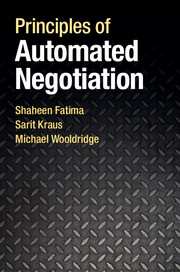Book contents
- Frontmatter
- Dedication
- Contents
- List of illustrations
- Preface
- Acknowledgements
- Summary of key notation
- 1 Introduction
- 2 Games in normal form
- 3 Games in extensive form
- 4 Negotiation domains
- 5 Strategic analysis of single-issue negotiation
- 6 Strategic analysis of multi-issue negotiation
- 7 The negotiation agenda
- 8 Multilateral negotiations
- 9 Heuristic approaches
- 10 Man–machine negotiations
- 11 Axiomatic analysis of negotiation
- 12 Applications
- 13 Related topics
- 14 Concluding remarks
- Appendix A Proofs
- References
- Index
2 - Games in normal form
Published online by Cambridge University Press: 05 November 2014
- Frontmatter
- Dedication
- Contents
- List of illustrations
- Preface
- Acknowledgements
- Summary of key notation
- 1 Introduction
- 2 Games in normal form
- 3 Games in extensive form
- 4 Negotiation domains
- 5 Strategic analysis of single-issue negotiation
- 6 Strategic analysis of multi-issue negotiation
- 7 The negotiation agenda
- 8 Multilateral negotiations
- 9 Heuristic approaches
- 10 Man–machine negotiations
- 11 Axiomatic analysis of negotiation
- 12 Applications
- 13 Related topics
- 14 Concluding remarks
- Appendix A Proofs
- References
- Index
Summary
As we saw in Chapter 1, the purpose of negotiation is to resolve a conflict between individuals and reach a mutually acceptable agreement with respect to some domain. A classic example of such conflict occurs when there are some scarce resources, and the individuals in question must reach a mutually acceptable agreement over how to divide/allocate the resources between themselves. The resources could be anything the individuals want: commodities, services, money, food, and so on. Typically, the negotiating individuals will have conflicting preferences over the possible divisions. Negotiation can be used to find a mutually acceptable way of dividing the resources. In this chapter, we will show how game theory can be used to analyse situations in which participants have conflicting preferences. We will later apply these techniques to the analysis of negotiation settings.
Before we start our analysis of such situations, we must identify and extract the information that is required to understand a situation of conflicting preferences. This information is represented in a game-theoretic model. In general, the models used in game theory represent abstractions of the underlying domain, which aim to capture all and only those aspects of the domain that are relevant for the decisions that must be made by those participating in it. The mathematical models of such conflicts of interests are called games.
- Type
- Chapter
- Information
- Principles of Automated Negotiation , pp. 17 - 34Publisher: Cambridge University PressPrint publication year: 2014



